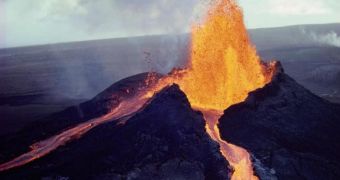The Kīlauea volcano in the Hawaiian Islands huffs and puffs in different styles on different occasions. Thus, it sometimes erupts fairly violently, while other times it has effusive eruptions, meaning that lava merely pours out onto the ground.
Scientists have for some time now been trying to make head and tail of Kīlauea's behavior, and the one thing that they know for sure is that the volcano's odd huffing and puffing patterns have nothing to do with the fact that it sometimes smokes cigarettes and on other days it lights up cigars.
In a recent paper in the journal Nature Geoscience, a team of scientists explain that, according to evidence at hand, the variability in eruption styles documented in the case of the Kīlauea volcano on the Big Island of Hawaii has to do with the makeup of deep magma.
Specifically, researchers say that gas-rich magma must be held accountable for the volcano's more explosive and violent eruptions. “Gas-rich magmas are ‘predisposed’ to rise quickly through the Earth's mantle and crust and erupt powerfully,” explains specialist Bruce Houghton.
By comparison, magma whose gas content is not that elevated has been shown to be the reason why the Kīlauea volcano sometimes has effusive eruptions during which lava merely ends up flowing on its slopes, the researcher further details.
“Pre-existing wisdom had it that the form of an eruption was principally decided during the last kilometer of rise towards the surface. But now we know the content of dissolved gas at the deep source is a key,” Bruce Houghton stresses.
Science Daily tells us that the scientists who worked on this research project base their claims that magma composition strongly influences the Kīlauea volcano's eruption styles on information collected while looking at 25 eruptions documented over the past 600 years.
As part of this investigation, the specialists analyzed the physical and chemical properties of eruption products. The end goal was to determine the makeup and especially the gas content of magma released by the Kīlauea volcano during said time frame.
Bruce Houghton and fellow researchers say that their work will really come in handy when the time comes to predict the form and the path that an eruption will take even before it actually occurs. Such information can help make sure that the damage caused by volcanic eruptions is kept at a minimum.
Still, the fact remains that, although magma composition influences eruption styles to a considerable extent, other variables need also be taken into consideration. “Other statistics like a volcano's volume, eruption rate, and duration are keys to real-time hazard and risk mapping. They are the target of approaches like ours,” Bruce Houghton explains.

 14 DAY TRIAL //
14 DAY TRIAL //